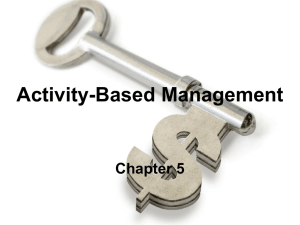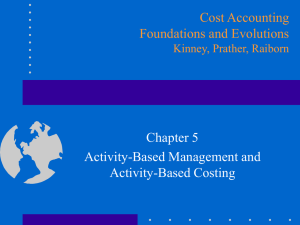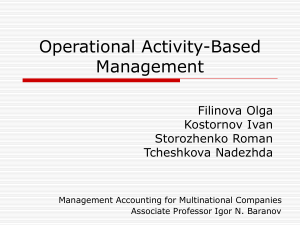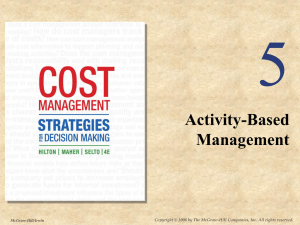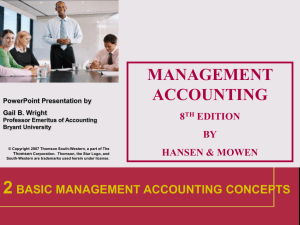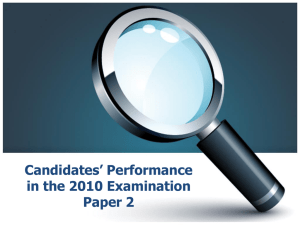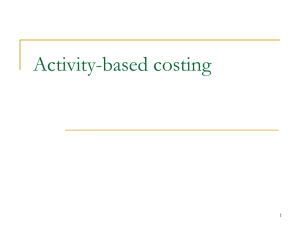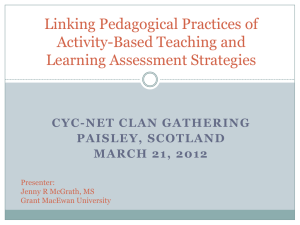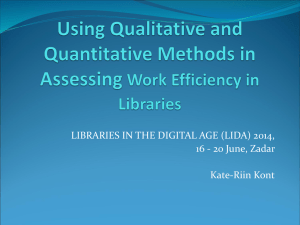NON-VALUE-ADDED ACTIVITIES
advertisement
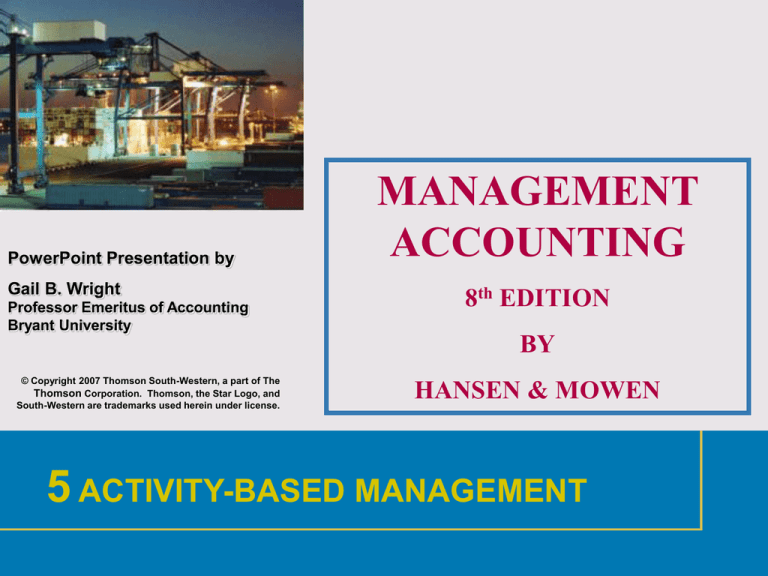
PowerPoint Presentation by Gail B. Wright Professor Emeritus of Accounting Bryant University MANAGEMENT ACCOUNTING 8th EDITION BY © Copyright 2007 Thomson South-Western, a part of The Thomson Corporation. Thomson, the Star Logo, and South-Western are trademarks used herein under license. HANSEN & MOWEN 5 ACTIVITY-BASED MANAGEMENT 1 LEARNING OBJECTIVES LEARNING GOALS After studying this chapter, you should be able to: 2 LEARNING OBJECTIVES 1. Describe activity-based management & explain its relationship to activity-based costing. 2. Explain process value analysis. 3. Describe activity performance measurement. 4. Describe activity-based customer & supplier costing Click the button to skip Questions to Think About 3 QUESTIONS TO THINK ABOUT: Roberts Truck Products (RTP) Why is accurate cost information about customers & suppliers important? What is wrong with the claim that all customers are good customers? 4 QUESTIONS TO THINK ABOUT: Roberts Truck Products (RTP) Will accurate cost information guarantee that a firm is competitive? 5 QUESTIONS TO THINK ABOUT: Roberts Truck Products (RTP) How can managing activities increase efficiency? How can we determine whether activities are of value to a firm? 6 QUESTIONS TO THINK ABOUT: Roberts Truck Products (RTP) What role, if any, do cost reports play in managing activities? 7 LEARNING OBJECTIVE 1 Describe activity-based management & explain its relationship to activitybased costing. 8 LO 1 ACTIVITY-BASED MANAGEMENT: Definition A systemwide, integrated approach that focuses management’s attention on activities for improving customer value and profit. 9 LO 1 2-DIMENSIONAL ABM MODEL 2-dimensional model shows intersection of cost & process. EXHIBIT 5-1 10 LO 1 ABM MODEL: Cost Dimension Information about resources, activities, cost objects such as Useful for products, customers, suppliers, distribution channels Objective: improving accuracy of cost assignments 11 LO 1 ABM MODEL: Process Dimension Information about What activities are performed Why activities are performed How well they are performed Objective: cost reduction Provides ability to engage in & measure continuous improvement 12 LO 1 ABM & ABC ABM incorporates & extends ABC ABM objectives Inproving decision making with accurate cost information Reducing costs by encouraging, supporting continuous improvements efforts 13 LO 1 EXHIBIT 5-2 ABM IMPLEMENTATION MODEL 14 LO 1 SYSTEMS PLANNING Addresses these issues Purpose, objectives of ABM system Organizations current & desired competitive position Organization’s business processes & product mix Timeline, assigned responsibilities, resources required for implementation Ability of organization to implement, learn, use new information 15 LO 1 ACTIVITY IDENTIFICATION, DEFINITION, CLASSIFICATION Knowing tasks that define activity helps improve efficiency Classifying activities allows ABM to connect with other continuous improvement initiatives JIT manufacturing TQM Total environmental quality cost management 16 LO 1 WHY DOES ABM FAIL? Implementation failure due to Lack of support from higher level management Results that do not occur as expected Significant investment in education, training not made Resistance to change Failure to integrate new system 17 LO 1 ABM & RESPONSIBILITY ACCOUNTING Responsibility accounting is fundamental tool of managerial accounting control Also related to process value analysis (PVA) Assigning responsibility Establishing performance measures, benchmarks Evaluating performance Assigning rewards 18 LO 1 RESPONSIBILITY ACCOUNTING SYSTEM 3 ways to assign responsibility and measure performance Financial (functional)-based system Activity-based system Strategic-based system (Ch. 16) 19 LO 1 FINANCIAL-BASED SYSTEMS Assigns responsibilities, measures performance in financial terms Useful in environments with slow or little change Concrete pipes, blocks Well- defined or relatively stable environments 20 LO 1 ACTIVITY-BASED SYSTEMS Developed for firms in continuous improvement environment Assigns responsibilities to processes Uses both financial & nonfinancial measures of performance Useful in environment that experience rapid change Computer technology 21 LO 1 COMPARING SYSTEMS: Assigning Responsibilities Assignment emphasizes improvement Assignment based on function EXHIBIT 5-4 22 LO 1 COMPARING SYSTEMS: Measuring Performance Process improvement measures Financial performance measures EXHIBIT 5-5 23 LO 1 COMPARING SYSTEMS: Evaluating Performance Evaluates time, quality, efficiency & financial standards Meet/beat financial standard EXHIBIT 5-6 24 LO 1 GAINSHARING: Definition ABM system allows employees to share in gains related to specific improvement projects. 25 LEARNING OBJECTIVE 2 Explain process value analysis. 26 LO 2 PROCESS VALUE VALUE ANALYSIS: PROCESS ANALYSIS: Definition Definition PVA emphasizes accountability for activities rather than costs; focuses on systemwide performance. 27 LO 2 PVA CONCERNS Driver analysis Activity analysis Activity performance measurement 28 LO 2 DRIVER ANALYSIS:Definition Definition ROOT CAUSES: Understanding what causes activity costs by understanding activity inputs & outputs; most basic causes for an activity being performed. 29 LO 2 Why are “root causes” so important? Because the root cause of 1 activity may be root cause of related activities. 30 LO 2 ACTIVITY ANALYSIS: Definition The process of identifying, describing, evaluating the activities an organization performs. 31 LO 2 ACTIVITY ANALYSIS OUTCOMES What activities are done How many people perform the activities Time, resources required to perform activities Assessing value of activities to organization Activities can be classified as Value-added Non-value-added 32 LO 2 What are “value-added” activities? Value-added activities are activities that are necessary to remain in business. 33 LO 2 VALUE-ADDED ACTIVITIES Are Mandatory to comply with laws Discretionary Produces a change of state Not achievable by preceding activities Enables other activities to be performed Performed at a value-added cost to achieve perfect efficiency Eliminate waste & reduce costs 34 LO 2 NON-VALUE-ADDED ACTIVITIES Are unnecessary Fail to satisfy 3 defining conditions of value-added activities Incur non-value-added costs of inefficiency 35 LO 2 NON-VALUE-ADDED ACTIVITIES: Examples Scheduling Moving Waiting Inspecting Storing Challenge of activity analysis: produce goods without using non-value-added activities. 36 LO 2 KAIZEN COSTING: Definition The effort to reduce costs of existing products & processes. 37 LO 2 REDUCING COSTS Activity elimination Focusing on non-value-added activities Activity selection Choosing among different sets of activities Activity reduction Reducing time, resources required Activity sharing Using economies of scale 38 LO 2 ACTIVITY PERFORMANCE MEASUREMENT: Definition Assessing how well an activity was performed and results achieved using both financial & nonfinancial measures. 39 LO 2 ACTIVITY PERFORMANCE MEASURES Efficiency Relationship of activity inputs & outputs Quality Doing it right the first time Time Shortening activity time 40 LEARNING OBJECTIVE 3 Describe activity performance measurement. 41 LO 3 FINANCIAL MEASURES OF ACTIVITY PERFORMANCE For potential & actual savings Value- & non-value-added activity cost reports Trends in activity cost reports Kaizen standard setting Benchmarking Life-cycle costing 42 LO 3 VALUE-ADDED STANDARD Calls for elimination of non-value-added activities Identifies optimal activity output Compares actual to value-added activity costs allowing management to Assess level of activity inefficiency Determine potential for improvement 43 LO 3 FORMULAS SQ: value-added output level SP: standard price per output measure AQ: actual quantity used of flexible resources Value-added = SQ x SP Non-value-added costs = (AQ – SQ)SP EXHIBIT 5-8 44 LO 3 COST REPORT: Step 1 Activity Activity Driver SQ* AQ* SP* Welding Welding hours 10,000 12,000 $40 Rework Rework hours 0 10,000 9 Setups Setup hours 0 6,000 60 Inspection # Inspections 0 4,000 15 45 LO 3 COST REPORT: Step 2 Activity ValueAdded Costs Non-ValueAdded Costs Actual Costs Welding $400,000 $80,000 $480,000 Rework 0 90,000 90,000 Setups 0 360,000 360,000 Inspection 0 60,000 60,000 $ 400,000 $ 590,000 $ 990,000 Total EXHIBIT 5-9 47 LO 3 COST REPORT: Step 2 Activity ValueAdded Non-ValueAdded Actual Costs Welding $400,000 $80,000 $480,000 Rework 0 90,000 90,000 Setups 0 360,000 360,000 Inspection 0 60,000 60,000 $ 400,000 $ 590,000 $ 990,000 Total Cost report emphasizes the opportunity for improvement. EXHIBIT 5-9 48 LO 3 TREND REPORTING Allows management to follow up on actions taken to reduce costs by examining whether outcomes were as expected. 49 LO 3 TREND REPORT: Step 3 Non-Value-Added Costs Activity Last Year Current Year Change Welding $80,000 $50,000 $30,000 Rework 90,000 70,000 20,000 Setups 360,000 200,000 160,000 60,000 35,000 25,000 $ 590,000 $ 355,000 $ 235,000 Inspection Total Trend report shows improvement that has been made. EXHIBIT 5-10 50 LO 3 What is kaizen costing? Kaizen costing helps reduce costs by repeated use of 2 subcycles: 1) continuous improvement, and 2) maintenance. 51 LO 3 BENCHMARKING: Definition Uses “best practices” as the standard for evaluating activity performance with the goal of becoming the best at performing activities & processes. 52 LO 3 ACTIVITY CAPACITY : Definition Activity drivers measure activity capacity, that is the number of times an activity can be performed. 53 LO 3 CAPACITY VARIANCES Unused capacity, the difference between activity availability & activity usage, needs management attention to reduce costs. 54 LEARNING OBJECTIVE 4 Describe activitybased customer & supplier costing. 55 LO 4 ACTIVITY-BASED CUSTOMER & SUPPLIER COSTING By applying the approach of activitybased costing to customers and suppliers, managers can identify & reduce true cost of these relationships. 56 LO 4 ACTIVITY-BASED CUSTOMER COSTING: An Example Large Customer Order-filling costs Sales force costs 10 Smaller Customers $ 4,000 $ 400,000 10,000 210,000 ABC costing shows comparative cost of larger & smaller customers, assuming same number of units sold. 57 LO 4 ACTIVITY-BASED SUPPLIER COSTING Identifies costs other than price such as Quality Reliability Delivery timeliness for management to consider when selecting suppliers 58 CHAPTER 5 THE END 59
